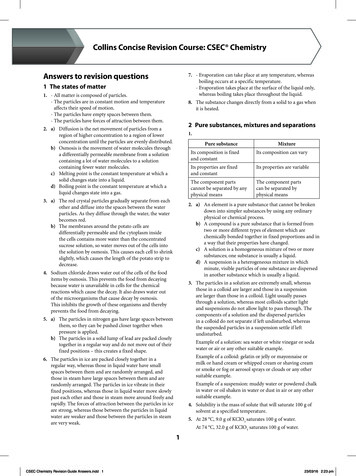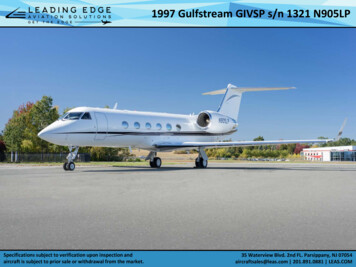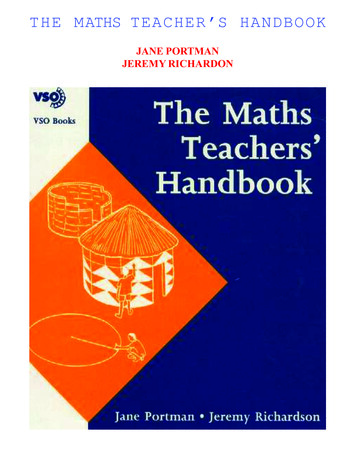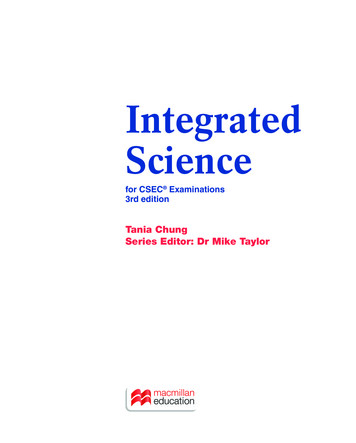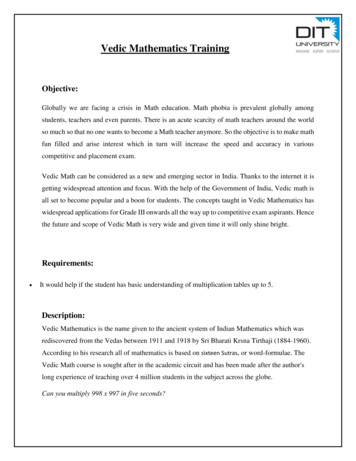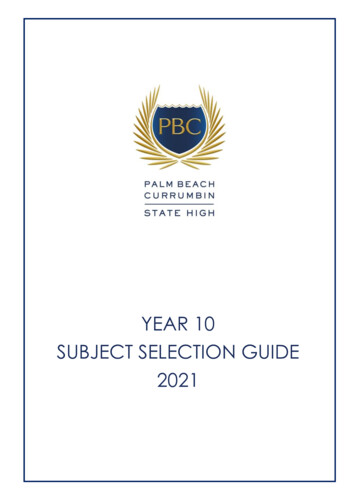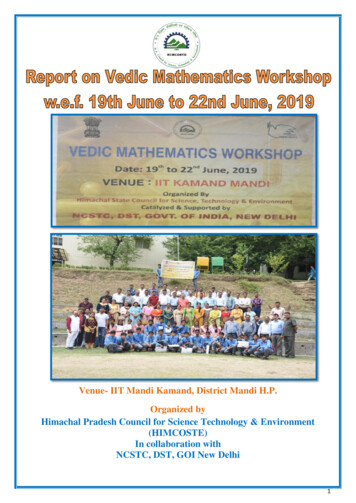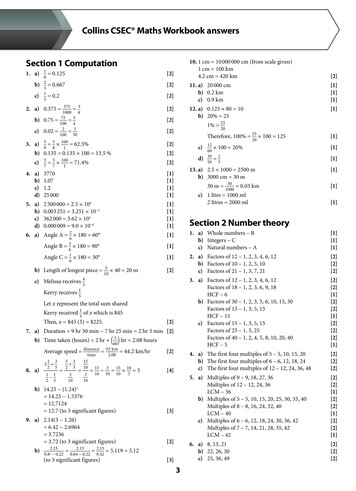
Transcription
Collins CSEC Maths Workbook answersSection 1 Computation1. a)b)c)182315 0.125[2] 0.667[2] 0.2[2]375100075 1002 1002. a) 0.375 b) 0.75 c) 0.02 3. a)58 3[2]34150[2]857137701.071.225 000[1][1][1][1]5. a)b)c)d)2 500 000 2.5 1060.003 251 3.251 10 3362 000 3.62 1050.000 009 9.0 10 6[1][1][1][1]6. a)Angle A 2 180 60 6Angle B 3 180 90 6Angle C 1 180 30 6[1]c) Melissa receivesd) 40 20 m[2]5Kerry received 1 of x which is 455[2]7. a) Duration 9 hr 30 min 7 hr 25 min 2 hr 5 min [2](605 ) hr 2.08 hoursAverage speed distance 92 km 44.2 km/hr1 1 2 5 310 time1510 15103102.08 310 15 10 5103[2][4]2b) 14.25 (1.24) 14.25 1.5376 12.7124 12.7 (to 3 significant figures)[3]9. a) 2.14(3 1.26) 6.42 2.6964 3.7236 3.72 (to 3 significant figures)[2]b)2.150.82 0.22 2.15 2.150.64 0.22 0.42(to 3 significant figures) 15[1]301000 0.03 km[1][1][1]Section 2 Number theoryLet x represent the total sum sharedb) Time taken (hours) 2 hr [1] 100 20%c) 1 litre 1000 ml2 litres 2000 ml45Then, x 45 (5) 225.[1]1260105030 m [1]510Therefore, 100% 25 100 12513. a) 2.5 1000 2500 mb) 3000 cm 30 mKerry receives 18. a)[1]c)[1]b) Length of longest piece 5 3 2 512. a) 0.125 80 10b) 20% 2520[2]14. a)b)c)d)1 32 2 5[1][1][1]20[2] 5 100 71.4%711. a) 20 000 cmb) 0.2 kmc) 0.9 km1% 25[2]b) 0.135 0.135 100 13.5 %c)[2][2] 5 100 62.5%810. 1 cm 10 000 000 cm (from scale given)1 cm 100 km4.2 cm 420 km 5.119 5.12[3]31. a) Whole numbers – Bb) Integers – Cc) Natural numbers – A[1][1][1]2. a) Factors of 12 – 1, 2, 3, 4, 6, 12b) Factors of 10 – 1, 2, 5, 10c) Factors of 21 – 1, 3, 7, 21[2][2][2]3. a) Factors of 12 – 1, 2, 3, 4, 6, 12Factors of 18 – 1, 2, 3, 6, 9, 18HCF – 6b) Factors of 30 – 1, 2, 3, 5, 6, 10, 15, 30Factors of 15 – 1, 3, 5, 15HCF – 15c) Factors of 15 – 1, 3, 5, 15Factors of 25 – 1, 5, 25Factors of 40 – 1, 2, 4, 5, 8, 10, 20, 40HCF – 5[2][2][1][2][2][1][2][2][2][1]4. a) The first four multiples of 5 – 5, 10, 15, 20b) The first four multiples of 6 – 6, 12, 18, 24c) The first four multiples of 12 – 12, 24, 36, 48[2][2][2]5. a) Multiples of 9 – 9, 18, 27, 36Multiples of 12 – 12, 24, 36LCM – 36b) Multiples of 5 – 5, 10, 15, 20, 25, 30, 35, 40Multiples of 8 – 8, 16, 24, 32, 40LCM – 40c) Multiples of 6 – 6, 12, 18, 24, 30, 36, 42Multiples of 7 – 7, 14, 21, 28, 35, 42LCM – 42[2][2][1][2][2][1][2][2][1]6. a) 8, 13, 21b) 22, 26, 30c) 25, 36, 49[2][2][2]
7. a) Distributive lawb) Associative lawc) Commutative law4. a) TT 6.30 US 1.00[1][1][1]TT 5000 US (50006.30 1.00) US 793.65b) Amount left US 793.65 US 650 US 143.65US 1.00 TT 6.30US 143.65 TT (143.65 6.30) TT 905[3]8. a) 110112 (1 24) (1 23) (0 22) (1 21) (1 20) 16 8 0 2 1 27[2]b) 2324 (2 42) (3 41) (2 40) 32 12 2 46[2]c) 12425 (1 53) (2 52) (4 51) (2 50) 125 50 20 2 197[2]5. a) Percentage profit selling price cost price 100%cost price 420 000 350 000 100350 000 20%[2]b) Loss 75 000 40 000 35 000Percentage loss losscost price9. a) 2 152 7R12 3R12 1R10R1Depreciation after 1 year 0.10 180 000 18 000Value of car after 1 year 180 000 18 000 162 000[2]ii) Depreciation after 2 years 0.10 162 000 16 200Value of car after 2 years 162 000 16 200 145 800[2][2]b) 5 27R25 1R00R16. a) i)1025c) 8 9028 1R30R1100(132810. a)Total interest repaid P R T 120 000 10 5100() 10 000 1 [2]2.51005) 11 314.08Compound interest 11 314.08 10 000 1314.08 [2]1101102 1100127. a) Discount 10% 6500 650Amount paid 6500 650 5850b) Tax 15% 3000 450Amount paid 3000 450 34501001111Answer – 10011112100 60 000[2]ii) Total amount of money repaid 60 000 120 000 180 000[2]180 000iii) Monthly instalment 5 12 3000 per month[2]nb) Amount P 1 R[2]8 11 R 100% 35 000 100 46.7%75 000[2]c) i)111125 5[2][3]b) 11112 10012[2][2]Section 4 Sets0110Answer – 11021. a) n(U) 19b) A {6, 9, 12, 15, 18, 21}c) B {5, 7, 9, 11, 13, 15, 17, 19, 21}d)U[3]Section 3 Consumer arithmetic1. a) Total hire purchase price 800 (300 10) 800 3000 3800b) Money that would be saved 3800 3000 800[2][1]82. a) Amount received by the grocer 120 32 3840 [1]b) Profit 3840 3360 480[1]c) Percentage profit 4803360 100 14.3%3. a) Hourly rate 600 15 per hour40b) Overtime rate 1.5 15 22.50Overtime wage 8 22.50 180c) Wage for 40 hours 40 15 600Wage for 10 hours overtime 10 22.50 225Total wage 600 225 ]2. a)b)c)d)[2][3]4n(A) 8n(B) 5A B {9, 11, 15}A B {2, 3, 4, 5, 7, 9, 11, 13, 15, 17}[3][1][1][1][1]
U3. a)A7. a)Bn(u) 36n(B) 2525 – xn(C) 18x18 – x[1]2Ub)A[3]Bb) 25 x x 18 x 2 3645 x 36x 45 36x 98. a)n(u) 40n(B) 23[1]Uc)A[2]n(C) 156–xB8 x4 xx9–x5–x4 x[1]2Ud)A[6]b) 8 x 6 x x 9 x 4 x 5 x 4 x 2 40x 38 40 [2]c) x 38 40x 40 38x 2[2]d) n(Biology only) 8 x 8 2 10[1]e) n(Chemistry and Biology only) 6 x 6 2 4 [1]B[1]4. a) Number of subsets 23 8b) { }, {2}, {4}, {6}, {2, 4}, {2, 6}, {4, 6}, {2, 4, 6}[1][2]5. a)b)c)d)InfiniteFiniteFiniteInfinite[1][1][1][1]6. a)b)c)d)e)f)g)h)B and ED is a subset of BB and C OR C and DAB, D OR EC4Number of subsets 24 16[1][1][1][1][1][1][1][1]n(P) 18Section 5 Measurement1. a) C 2πr 2 3.14 6 37.68 cmb) A πr2 3.14 62 113 cm2[2][2]θ A 120 113 37.7 cm2 [2]360360Area of triangle AOB 1 ab sin C 1 6 6 sin 120 22c) Area of minor sector d) 15.6 cm2e) Area of shaded region 37.7 15.6 22.1 cm2f) Length of minor arc g) Length of major arc 5[2][2]θ C 120 37.68 12.56 cm [2]360360θ C 240 37.68 25.12 cm [2]360360
h)m6cAd) Volume of cylinder πr 2h 3.14 22 6 75.36 cm3 [2]120 30 6ce) TOTAL volume of the two hemispheres (or one sphere) 4 πr 3 4 π(2)3m3X7. a) BDC 30 (BDC is an isosceles triangle)b) DBC 180 (30 30) 180 60 120 ABD 150 120 30 AX 6 cos 30 5.2 cmAB 2 5.2 10.4 cmPerimeter of shaded region length of minor arc AB 12.56 10.4 22.96 cm [2]2. a) A l b 6 8.2 49.2 cm2b) V A h 49.2 12 590 cm3c) Total surface area 2 (12 6) 2 (12 8.2) 2 (6 8.1) 144 196.8 98.4 439.2 cm23 33.49 cm3f) TOTAL volume of perfume bottle 75.36 33.49 108.85 cm3B[2][2]28. a) Area of trapezium 1 (8 10) 6 54 cm22b) 110 x 120 60 360x 290 360x 360 290x 70 [4][1]1. a)Score (x)TallyFrequency (f )x f1 332 483 4124 4165 2106 848[4]7 174. a) Area of shaded cross-section πr 2 3.14 22 12.56 cm2[2]2b) Volume of cylinder πr h 12.56 8 100.48 cm3 [2]c) Area of curved part of cylinder h 2πr 8 2 3.14 2 100.48 cm2[2]8 3249 19 () (4 4) (π(2)22) 4 16 6.28[3] 26.28 cm2b) Total area Area ofrectangle ABCD Area of semi-circle (8 6) (π(4)22) 48 25.12 22.88 m25. a) i)ii)b) i)ii)Length of one side of square 196 14 cmPerimeter of square 4 14 56 cmCircumference 56 cm2πr 56r 562227 8.91 cmb) Mode 6c) Median 4 5 4.5d) Mean [2][1][1] 4.6[3]e) Probability (score 5) 2. a)[2]713730[2]6. a) Curved surface area of the cylinder 2πrh[2] 2 3.14 2 6 75.36 cm2b) TOTAL surface areas of the two hemispheres(or one sphere) 4πr 2 4 3.14 22 50.24 cm2[2]c) TOTAL surface area of perfume bottle 75.36 50.24 125.6 cm2 [1]6[5][1][1]2( )iii) Area of circle πr 2 22 (8.91)2 249.5 cm2[2]Section 6 Statistics3. a) Total area Area of triangle Area of square Area of semi-circle1 2 42[1][2]c) ADB 180 30 75 [2][2][2]8 1 3 130 1330Height (cm)Number ]
b)b) (See graph)fuel10018ºutilities9048º 54º60º180º80rentsavings70cumulative frequencyfood[3]604. a) Mean score 505. a)b)c)d)e)f)302010 10 6.1 [2]14–1614–1610.516.57.5 4.5 3See graph[2][1][1][1][1][1][1]1410203040height / cm5060Lower quartile 22 cmMedian 32 cmUpper quartile 38 cmInterquartile range 38 22 16 cmSemi-interquartile range 16 8 cmd) i)P (less than 35 cm) [5][1][1][1][1][1]262100 0.62ItemBudgeted amount15100 0.15rent 1000food 9009006000 360 54 fuel forher car 3003006000 360 18 utilities 8008006000 360 48 Total 3000 6000[1]30006000 360 60 86Angle of sector inpie chart10006000savings10[1]ii) P (greater than 42 cm) 100 85 10012frequency0c) i)ii)iii)iv)v)3. a)1061b) Arrange the scores in ascending order to find themedian – 5, 5, 6, 6, 6, 6, 6, 7, 7, 7Median score 6c) Modal score 6 (most frequent score)4006 5 7 7 6 5 6 6 6 7420010age6. a) Number of letter Ms 2Number of letters 112P (selecting an M) 11 360 180 360 515[4][2]5b) Number of yellow balls 8 40 25[4]20[2]5 1 1 30 16 [2]c) P (student scores more than 6) 1 2 307
b) y x2y kx216 k (2)2Section 7 Algebrax 31. a) i) 42x 133(x 3) 4(2x 1)12 3x 9 8x 412 11x 512ii) 2x 1 x 3323(2x 1) 2(x 1) 66x 3 2x 2 64x 5 67x 1 2x 1 453 b)k k 4Therefore, y 4x2When x a, y 6464 4a2[3]a2 4x2y(1 3xy2)(1 3x)(1 3x)(3x 1)(x 2)6p2 3pq 2p q 3p(2p q) (2p q) (3p 1)(2p q)3. a) mx c ymx y c2. a)b)c)d)x y c[3]b)When x a, y 33 [2]a xTkT2k2x a xaxk2 aT 2x aT 2k22[2]2 224. a) 3x y 6x y 3xyb) 2x 2y 6x2 3x 5x 2y 6x22c) 4x 5y5. a) 2 * 3 (2 3) 3(2)(3) 25 18 7b)(1)( 2) 3( 2)2 1[2][2] 5 15[2][2]6. a) y xy kx12 k(4)k 124k 3Therefore, y 3xWhen y 9, x a9 3a[3][3]2x 39Or x 3 0x 3221When x 3 , y 7 2 3 8 3a 3a 3When x 7, y bb 3(7) 21 3x 1Substituting x 1 into equation (2)y 3(1) 1 3 1 2b) y 2x 7 .(1)x2 xy 6 .(2)From equation (1), y 7 2xSubstituting equation (1) into equation (2)x2 x (7 2x) 6x2 7x 2x2 63x2 7x 6 0(3x 2)(x 3) 0Either 3x 2 03x 2[2]21247. a) 2x 3y 8 .(1)3x y 1 (2)From equation (2), y 3x 1Substiting equation (2) into (1)2x 3(3x 1) 82x 9x 3 811x 3 811x 8 311x 1111x 11[2] a123a 4When x 4, y bb T k12a3a 12aa[3]1y xky xk6 2k 6 2k 1212Therefore, y x[3][2][2][2]pq xpqx ax pqc)c)[2]m644a2 16a 16a 4When x 5, y bb 4(5)2b 1003(7x 1) 5(2x 1) 15 421x 3 10x 5 6031x 2 6031x 60 231x 6262x 31x 2164( )When x 3, y 7 2(3) 1[3]8[6]
c) 6x2 13x 5 0(2x 1)(3x 5) 0Either 2x 1 02x 18. a) 2x 8 122x 12 82x 20x 202x 102x3b)1x 2[2]xOR 3x 5 03x 5 2 64x 3x 367x 3636x 75x 313. a) 2x 5x 1 0a 2, b 5, c 1[3]c) 8 2x 2 2x 2 8 2x 62x 66x 29. a) i) 50 xii) 50x 35(50 x)b) i) 50x 1750 35x 220015x 2200 175015x 450x [1][1]ii) 50 30 201x 4002First piece xSecond piece x 2Third piece 3xii) x (x 2) 3x 5x 2iii) 5x 2 425x 42 25x 40c)a 3 b4ab b b 2 4ac2a[3][1]x 7 72 4(1)( 2)2(1)[2]x 7 572 7 57Either x 2OR x [2][1][4][2][2][2][1][1]c) y mx cy 2x cWhen x 2, y 3 3 2(2) cc 4 3c 3 4c 7Therefore, the equation of the line is y 2x 7.[1]2[2]2. a) Gradient b) Midpoint 4x 3OR x 2 0x 2 7.271. a) Gradient 21b) Gradient 2[2]12. a) x 7x 10 0(x 5)(x 2) 0Either x 5 0x 5OR x 2 0x 2b) 3x2 10x 8 0(3x 4)(x 2) 0Either 3x 4 03x 4 5 572 0.27Section 8 Relations, functionsand graphs[3][1][1]d) y2[4]14. a) 2 18x2 2(1 9x2) 2(1 3x)(1 3x)b) (2x 3) (3x 4)c) (2p 3q) (4r s)405 a2b3 5 52 4(2)(1)2(2)x b) i)11. a) x8y4b) x3yx b) x2 7x 2 0a 1, b 7, c 245015x 30x 8 b b 2 4ac2a 5 174 5 17Either x 4 0.22 5 17OR x 4 2.28[2]x x x x 310. a)[2]2y 2 y1x2 x1(11 110 3 ( 2) 5 2x1 x2 y 1 y 2 2 3 1 11, 2 2 , 22) ([3][1]) (12, 6)[2]c) Length (x2 x1)2 (y2 y1)2 (3 ( 2))2 (11 1)2[2] (5)2 (10)2 11.2 units9[2]
16. a) x 3 0x 3Therefore, when x 3, f (x) is undefined.b) g(2) 2 (2) 3 7d) Gradient of perpendicular bisector 2y mx c1When x 2 , y 61 1 c216 4 c1c 6 425c 4125Therefore, y 2 x 46 2()f (7) c) f (x) 2x 1x 3Step 1 – Interchange x and y[3]x 2y 1y 3Step 2 – Make y the subject of the formulax(y 3) 2y 1xy 3x 2y 1xy 2y 1 3xy(x 2) 1 3x[1]y 1 3xx 2Therefore, f 1(x) 1 3x[1][1]y321A27. a) 2x 5x 3 a(x b) c a(x2 2bx b2) c ax2 2abx ab2 cEquating coefficients:a 22ab 52(2)b 52 3 x(2, 0)5b 4ab2 c 35 22 4 c 3()–3c 3 –449–6B5. a) f (2) 5(2) 2 10 2 8b) f ( 1) 5( 1) 2 5 2 7[1][2]11g (4) 3(4) 1215fg(x) 5 3x 2 3x 211gf (x) 3(5x 2) 15x 6( ) 1Therefore, f (x) 498[3]b)5 49c) Coordinates of minimum point 4 , 82d) 2x 5x 3 0(2x 1)(x 3) 0Either 2x 1 02x 1x 25()[1][1]1x 2Or x 3 0x 3[1][2]e) f)[2]y[2]54f) y 5x 2Step 1 – Interchange x and yx 5y 2Step 2 – Make y the subject of the formula5y x 2x 25)5Axis of symmetry x 4[1][1][1][1][2]y 5(So f (x) 2 x 4 2 (0, –6)4. a) i) One-to-oneii) Many-to-oneiii) One-to-manyiv) Many-to-manyb) Functions – one-to-one, many-to-onee)258c 8–5d)[3]x 22–2c)[3]x 361154Let y 2x 1x 30–2 –1–1154 Therefore, fg(2) 3. a) When line meets x-axis, y 03x 6 03x 6x 2Therefore, A (2, 0)b) When the line meets the y-axis, x 0y 3(0) 6 6Therefore, B (0, 6)1c) Area of triangle OAB 2 2 6 6 units squared2(7) 17 3[1]3(–3, 0)21 ,0210–5 –4 –3 –2 –1–1[2]–2123 xminimum pointaxis of symmetry10[4]
8. a)b)c)d)e)f)g)9. a)x 3, x 1f (x) (x 3)(x 1) x2 3x x 3 x2 2x 3f (x) 5( 1, 4)x 1x 0, x 2 2 x 0xyb)161412108 2 10234565 3 4 305124f (x)01[2][2][2][2][2][2][2][10]2y0–5 –4 –3 –2 –1–21212345 x–410–6–88–10–126–14–164[4]c) From the graph, solutions are:( 2, 10) and (3, 0)d) x 4, x 3e) 4 x 3f) x 3, x 22–2–10123x5420 0211. a) a 30 0 3 ms 2–2b) a –4c) d [2]40 20 20 1 ms 250 30 2040 040 2 ms 2100 80 20[2][2] 2b) a 2b 5[2]c) x 1x 3[2]d) (1, 4)[1]e) Choose any two points on the tangent drawn at thepoint x 2.(5, 3) and (1, 5)Gradient 5 3 8 21 510. a)x 4 5 4 3 2 1d) a 0 mse) Distance Area of trapezium1 1600 m3432121060 8g(x) 1614121086420 2[2]13. a) x 2212[2][1]8c) Average speed 30 0.267 ms 111010b) 3.5 1 2.5 minutes06[2]d12. a) Average speed t 60 0.167 ms 1y0[1] 2 (30 50) 40[3]f (x) 8[2][2][2][2]1[6]0–3 –2 –1–1123 x–2–311x 2[1]
c) See shaded regionb) y 4y4B16y 43[2]A 41421210–4 –3 –2 –1–11234 x108–2–36[1]c) y 2x 3yy 2x 3021d) i)123x–3[1]d) y 3x 7y6y 3x 74321234 x4(5A 4B 5A B 156810121416 AP (4, 11)Q: y 252)17. a) y 2 x 4 –214. a) Inequality 1 :Inequality 2:Inequality 3:b) See graph215. a) i) y 0ii) x 0iii) y 4b) x 0y 0y 4y 6 x16. a) P: x 10,b) x 10y 2x y 15y x710Profit (4 6000) (11 7000) 101 000[1]Q (10, 5)Profit (10 6000) (5 7000) 95 000[1]R (4, 5)Profit (4 6000) (5 7000) 59 000[1]Quantity of refrigerator A 4Quantity of refrigerator B 11ii) Maximum profit 101 000[2]–20–2 –1–1A B 15230–4 –3 –2 –1–1B 1][1][1][1][2]b) x 4c) Two1d) x 2 and x 3[1][1][2]e) Maximum point. Coordinates of maximum point5 49 4, 8[2]()18. a) Let y 3x 2Interchanging x and yx 3y 23y x 2x 2y 3Therefore, f 1(x) x 23b) Let y 6 xInterchanging x and yx 6 yy 6 xTherefore, g 1(x) 6 x12[2][2]
x 32. a)c) Let y 2x 1Interchanging x and yy 3x 2y 1Cx(2y 1) y 32xy x y 32xy y 3 xy(2x 1) 3 x3 xy 2x 13 xTherefore, f 1(x) 2x 1[3]Section 9 Geometry andtrigonometry1. a)90º60º60ºA[3]B6 cmb) AC 10.4 cmb)[4][1]3. a) b)C30º[3]5.5 cmc)60ºA45ºX7.5 cmB[3]d)[5][1]Angle BCX 45 4.C120ºD[3]7 cmA138.1 cm6.4 cmB[5]
5. a) 2x x 1803x 180x 1803x 60 b) x 60 90x 90 60x 30 c) x 90 120 100 360x 310 360x 360 310x 50 d) d 60 (vertically opposite)a 180 60 120 c 120 (vertically opposite)e 120 (alternate)b 60 [2][1][2][1][1][1][1][1]6. a) 90 The angle in a semi-circle is a right angle.[1]b) 60 The angles subtended by a chord at the circumferenceof a circle and standing on the same arc are equal. [1]c) 180 80 100 The opposite angles of a cyclic quadrilateral aresupplementary.[1]d)6029. AB2 AC2 BC272 AC2 4.52AC2 72 4.52AC 28.75AC 5.4 cm[2]10. AB2 AC2 BC2AB2 42 5.22AB2 43.04AB 43.04AB 6.6 cm[2]11.tan 60 RQ RQ 6.9 cm7. a) QPR 80 [2]The angle formed by the tangent to a circle and achord, at the point of contact, is equal to theangle in the alternate segment.b) QOR 160 [2]The angle subtended by a chord at the centre of acircle is twice the angle that the chord subtends at thecircumference, standing on the same arc.c) QSR 180 (80 80) 180 160 20 [2]Tangents QS and RS are equal lengths. Triangle RQS isisosceles, making RQS 80 .8. a) ROC 60 [2]The angle subtended by a chord at the centre of acircle is twice the angle that the chord subtends at thecircumference, standing on the same arc.b) ABC 30 CAB 90 30 60 [2]c) OCQ 30 QCP 90 30 120 QPS 180 (120 30) 30 [2]d) QOC 120 COR 60 OCR 6tan Q 8Q tan 1(68)Q 36.9 [2]RQ13. sin RPQ PQRQsin 30 12RQ 12 sin 30 RQ 6 cm14. sin PQR sin PQR [2]PRPQ69PQR sin 1(69)PQR 41.8 [2]RQ15. cos PQR PQRQcos 42 8.2RQ 8.2 cos 42 RQ 6.1 cm[2]PR16. cos RPQ PQ3.8cos RPQ 9.4RPQ cos 1(3.89.4 )RPQ 66.2 [2]17. Using the sine ruleABsin C4sin CBC sin A 6sin 42 6 sin C 4 sin 42 sin C 4 sin 42 6C sin 1(0.446)C 26.5 [2]18. Using the sine ruleBCAB sin A sin CBC 9sin 20 sin 120 9 sin 20 BC sin 120 180 – 60 60 2RCA 90 60 30 [2]PR12. tan Q RQ 30 The angle subtended by a chord at the centre of acircle is twice the angle that the chord subtends at thecircumference, standing on the same arc.[1]e) 70 The angle formed by the tangent to a circle and achord, at the point of contact, is equal to the angle inthe alternate segment.[1]tanQ PRRQ12RQ12tan 60 BC 3.6 cm[2]14[2]
19. Using the cosine rulec2 a2 b2 2ab cos CBC 2 8.52 6.22 2(8.5)(6.2) cos 40 BC 2 29.95BC 29.95BC 5.5 cmii) Using the sine ruleasin A65sin 100 cos ABC 223. T Translationcos ABC 0.646ABC cos 1(0.646)ABC 49.8 [2]21. a)T1m40 tan 40 [3]iii) Bearing of O from B 180 30 49.2 259.2 [1]7 6.2 – 5.62(7)(6.2)b) tan 40 50 sin 100 65sin OBA 0.758OBA sin 1(0.758)OBA 49.2 2O50 sin OBAsin OBA [2]20. Using the cosine rulec2 a2 b2 2ab cos C5.62 72 6.22 2(7)(6.2) cos ABC2b sin BP30 Q(53)[3]24. Enlargement of scale factor 3Centre of enlargement ( 4, 8)[3]25. Reflection in the line x 4[2]26. a) i) (0, 0)ii) 90 iii) Anticlockwiseb) Congruent trianglesA' ( 2, 2) , B' (0, 2), C' (0, 1)c) Image after the transformationA" ( 1, 0), B" (1, 0) , C" (1, 1)d)[1][1][1][1][3]y[2]OTOP11OP311OP tan 40 13.1 m[2]2A’AB’11c) tan 30 OQ111OQ tan 30 C’COQ 19.1 m–2PQ OQ OP 19.1 13.1 6m–10B123x–1[3]22. a)–2–3110ºO65 kmB27. a) Sum of the interior angles of a triangle 180 .Triangle BCD is an isoseles triangle.30º50 kmCDB Ab) i)OAB 70 30 100 110º[5]65 km70º[1]NNO[3]BN50 km30º30º70ºA15180 642 58 [2]b) BAD 64 . The angles subtended by a chord at thecircumference of a circle and standing on the same arcare equal.[2]c) ADB 90 . The angle in a semi-circle is a right angle.ABD 180 (64 90) 26 [2]d) BDT 64 . The angle formed by the tangent to a circleand a chord, at the point of contact, is equal to theangle in the alternate segment.DT BT, therefore, triangle DBT is isosceles.DTB (180 (2 64)) 52 [2]
28. a)4. a) 3x ( 12) 153x 12 153x 15 123x 3NN60 km110º120ºAx 3N380 km60º70ºOBc)[3]( )( )( ) (10 01)[2]1 62 33 6 2 1[2]5. The determinant of a singular matrix is zero.(8 2) (x 4x) 016 4x2 04x2 16x2 164[4]x2 4Therefore x 2 or 260 sin OBAsin OBA [2]1151 1 615 2 3b) A 1 b) OAB 360 (120 110) 130 Using the cosine ruleOB2 OA2 AB2 (2 OA AB cos OAB)OB2 602 802 ( 2 60 80 cos 130)OB2 16 171OB 127.2 kmc) Using the sine rule127.2sin 130 x 16. a)60 sin 130 127.2[4]( )( ) ( )2 3 x5 2 y 11 1[2]b) Determinant of matrix A (2 2) (3 5) 19 [2]sin OBA 0.361OBA sin 1(0.361)OBA 21.2 The bearing of O from B 360 (70 21.2) 268.8 [4]d)( 32))( 23 )(xy) 191 ( 5 2 32)( 111)(xy) (13)1 219 5 1 2 3 219 5 2 5c) A 1 (x 1, y 3Section 10 Vectors and matrices1. a)b)c)d)e)( ) ( )( )( ) ( )( )( ) ( )( )( )( ) ( )( )( )( )( )( )()A B 1 3 2 1 2 21 3 3 4 1 1A 2B 1 3 2 2 1 2 21 3 5 50 4B 2A 2 1 2 1 31 3 2 2 0 55 7AB 1 3 2 1 5 8 2 2 1 3 2 8A2 1 3 1 3 2 2 2 2 5 9 6 2A2B 5 9 2 1 6 2 1 3 1 32 14 02. a) Determinant (4 2) (3 2) 8 ( 6) 14b) Determinant (2 8) (3 5) 1c) Determinant (5 2) (3 1) 13d) Determinant (6 2) (3 1) 93. a)b)c)d)( )( ) (( )( )1 2 314 2 41 8 3 8 31 5 2 5 21 2 313 1 5 1 2 39 1 6[2]c)[2]( ) ( ) ( )BC BO OC ( ) ( ) ( )AB ( 1 ) 3[2] AB 12 ( 3)2 3.16 units[2]d) Unit vector AB AB [2][2][2][2] 3 1 3 1 2 41 4 13 2 5( ) (1 13.16 3[2]3.16 0.949)[1]8. a) a b (2i j) (i 3j) 3i 2jb) a 2b (2i j) 2(i 3j) 2i j 2i 6j 7jc) a b (2i j) (i 3j) 2i j i 3j i 4j[2] a b 12 42 4.12 units[3][2]9. a)AQ[1][1][1]O[1]b) i)[2])[5]7. a) BA BO OA b)[2]ii)[2]iii)[2]iv)[2]16PB[2]BA BO OA b a[2]QB QO OB 2 OA OB 2 a b33AP AO OP a 1 b2QP QO OP 2 a 1 b32[2][2][2]
(24) (15) (39)BC BO OC ( 1) ( 3 ) ( 2) 5116AB ( 3)9BC ( 2)6BC 2 ( 3) 2AB3 9310. a) AB AO OB b)c)Therefore, BC and AB are parallel. They share acommon point B and hence A, B and C must becollinear.11. a) A (1, 3)B (3, 1)C (1, 1)b) i) Enlargement of scale factor 312. a)[2]b)c)d)e)[2][2][3]A' ( 3, 9)[1]B( 3 00 3C( 3 00 3ii)iii)[1])( ) ( )C' ( 3, 3)11 33( 10[1][4]AB AO OB a b[2]BP 1 BA 1 (a b) 1 a 1 b2222OP OA AP OA 1 AB a 1 ( a b)2211[2] a b2b)2iv) AQ AO OQ AO 1 OB a 1 b22AX AO OX AO 3 OP a 3 1 a 1 b55 22731017[2]0 11 40 10 a b[1][2]P" (10, 4)13. a) i) 93B' ( 9, 3)[2]) ( 10 10 ) (01 10)0P" ( 1 ) ( ) (10)4AC )( ) ( )31( 01 10 )( 10 10 )( 10 10 )( 24 ) 1 0 2 2 BD (0 1) ( 4 ) (4)426P' ( ) ( ) ( )10414P' (6, 14)[3]( 10 10) (30 03) ( 30 30)A ( 3 0) ( 1 ) ( 3 )0 3 39ii) Q P iii)[2]10()[2][2][3]
Collins CSEC Maths Workbook answers Section 1 Computation 1. a) 1 8 0.125 [2] b) 2 3 0.667 [2] c) 1 5 0.2 [2] 2. a) 0.375 375 1000 3 8 [2] b) 0.75 75 100 3 4 [2] c) 0.02 2 100 1 50 [2] 3. a) 5 8 5 8 100 1 62.5% [2] b) 0.135 0.135 100 13.5 % [2] c) 5 7 5 7 100 1 71.4% [2] 4. a) 3770 [1] b) 1.07 [1] c) 1.2 .
